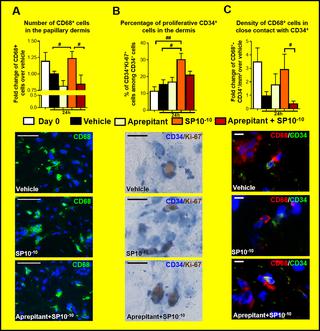Our official English website, www.x-mol.net, welcomes your
feedback! (Note: you will need to create a separate account there.)
Tissue-resident macrophages can be generated de novo in adult human skin from resident progenitor cells during substance P-mediated neurogenic inflammation ex vivo.
PLOS ONE ( IF 2.9 ) Pub Date : 2020-01-23 , DOI: 10.1371/journal.pone.0227817 Jennifer Gherardini 1 , Youhei Uchida 2 , Jonathan A Hardman 3 , Jérémy Chéret 4 , Kimberly Mace 5 , Marta Bertolini 1 , Ralf Paus 1, 3, 4
PLOS ONE ( IF 2.9 ) Pub Date : 2020-01-23 , DOI: 10.1371/journal.pone.0227817 Jennifer Gherardini 1 , Youhei Uchida 2 , Jonathan A Hardman 3 , Jérémy Chéret 4 , Kimberly Mace 5 , Marta Bertolini 1 , Ralf Paus 1, 3, 4
Affiliation

|
Besides monocyte (MO)-derived macrophages (MACs), self-renewing tissue-resident macrophages (trMACs) maintain the intracutaneous MAC pool in murine skin. Here, we have asked whether the same phenomenon occurs in human skin using organ-cultured, full-thickness skin detached from blood circulation and bone marrow. Skin stimulation ex vivo with the neuropeptide substance P (SP), mimicking neurogenic skin inflammation, significantly increased the number of CD68+MACs in the papillary dermis without altering intracutaneous MAC proliferation or apoptosis. Since intraluminal CD14+MOs were undetectable in the non-perfused dermal vasculature, new MACs must have differentiated from resident intracutaneous progenitor cells in human skin. Interestingly, CD68+MACs were often seen in direct cell-cell-contact with cells expressing both, the hematopoietic stem cell marker CD34 and SP receptor (neurokinin-1 receptor [NK1R]). These cell-cell contacts and CD34+cell proliferation were up-regulated in SP-treated skin samples. Collectively, our study provides the first evidence that resident MAC progenitors, from which mature MACs can rapidly differentiate within the tissue, do exist in normal adult human skin. That these NK1R+trMAC-progenitor cells quickly respond to a key stress-associated neuroinflammatory stimulus suggests that this may satisfy increased local MAC demand under conditions of wounding/stress.
中文翻译:

在物质P介导的神经源性炎症离体过程中,可从成体祖细胞在成年人类皮肤中重新产生组织驻留巨噬细胞。
除了单核细胞(MO)衍生的巨噬细胞(MAC),自我更新的组织驻留巨噬细胞(trMAC)还能维持鼠科动物皮肤内的MAC池。在这里,我们问过,使用器官培养的全厚度皮肤脱离血液循环和骨髓后,人类皮肤中是否会发生相同的现象。用神经肽物质P(SP)进行离体皮肤刺激,模仿神经源性皮肤炎症,可显着增加乳头状真皮中CD68 + MAC的数量,而不会改变皮内MAC的增殖或凋亡。由于在未灌注的真皮血管中无法检测到腔内CD14 + MO,因此新的MAC必须与人类皮肤中驻留的皮内祖细胞相区分。有趣的是,经常在与表达两种CD68 + MAC的细胞直接细胞接触中看到CD68 + MAC,造血干细胞标记CD34和SP受体(神经激肽1受体[NK1R])。在SP处理过的皮肤样品中,这些细胞间接触和CD34 +细胞增殖被上调。总的来说,我们的研究提供了第一个证据,即在正常的成年人皮肤中确实存在常驻MAC祖细胞,成熟的MAC可从中迅速分化出组织内的常驻MAC。这些NK1R + trMAC祖细胞对关键的应激相关神经炎性刺激快速反应,这表明这可能满足伤口/应激条件下局部MAC需求的增加。正常的成年人皮肤中确实存在成熟的MAC可以从中迅速分化出组织内的MAC。这些NK1R + trMAC祖细胞对关键的应激相关神经炎性刺激快速反应,这表明这可能满足伤口/应激条件下局部MAC需求的增加。正常的成年人皮肤中确实存在成熟的MAC可以从中迅速分化出组织内的MAC。这些NK1R + trMAC祖细胞对关键的应激相关神经炎性刺激快速反应,这表明这可能满足伤口/应激条件下局部MAC需求的增加。
更新日期:2020-01-24
中文翻译:

在物质P介导的神经源性炎症离体过程中,可从成体祖细胞在成年人类皮肤中重新产生组织驻留巨噬细胞。
除了单核细胞(MO)衍生的巨噬细胞(MAC),自我更新的组织驻留巨噬细胞(trMAC)还能维持鼠科动物皮肤内的MAC池。在这里,我们问过,使用器官培养的全厚度皮肤脱离血液循环和骨髓后,人类皮肤中是否会发生相同的现象。用神经肽物质P(SP)进行离体皮肤刺激,模仿神经源性皮肤炎症,可显着增加乳头状真皮中CD68 + MAC的数量,而不会改变皮内MAC的增殖或凋亡。由于在未灌注的真皮血管中无法检测到腔内CD14 + MO,因此新的MAC必须与人类皮肤中驻留的皮内祖细胞相区分。有趣的是,经常在与表达两种CD68 + MAC的细胞直接细胞接触中看到CD68 + MAC,造血干细胞标记CD34和SP受体(神经激肽1受体[NK1R])。在SP处理过的皮肤样品中,这些细胞间接触和CD34 +细胞增殖被上调。总的来说,我们的研究提供了第一个证据,即在正常的成年人皮肤中确实存在常驻MAC祖细胞,成熟的MAC可从中迅速分化出组织内的常驻MAC。这些NK1R + trMAC祖细胞对关键的应激相关神经炎性刺激快速反应,这表明这可能满足伤口/应激条件下局部MAC需求的增加。正常的成年人皮肤中确实存在成熟的MAC可以从中迅速分化出组织内的MAC。这些NK1R + trMAC祖细胞对关键的应激相关神经炎性刺激快速反应,这表明这可能满足伤口/应激条件下局部MAC需求的增加。正常的成年人皮肤中确实存在成熟的MAC可以从中迅速分化出组织内的MAC。这些NK1R + trMAC祖细胞对关键的应激相关神经炎性刺激快速反应,这表明这可能满足伤口/应激条件下局部MAC需求的增加。











































 京公网安备 11010802027423号
京公网安备 11010802027423号